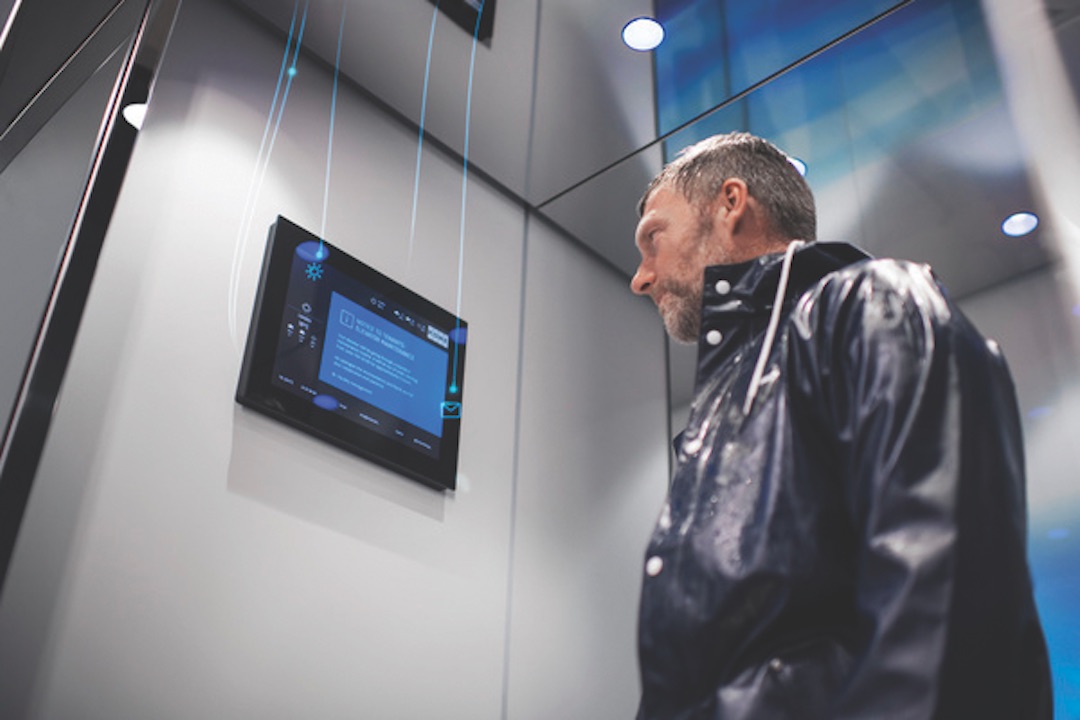KONE Corporation has announced a new elevator technology that could make it possible for supertall buildings to reach greater heights by eliminating several problems of existing elevator technology. The firm's new UltraRope hoisting system uses a rope with a carbon-fiber core and high-friction coating, rather than conventional steel rope. UltraRope is comparatively lightweight, requiring 15% less energy for moving hoisting ropes, compensating ropes, counterweights, elevator cars, and passengers, according to KONE.
In addition, carbon fiber resonates at a different frequency than steel and other typical building materials, a property that is predicted to reduce downtime attributable to building sway. KONE estimates that the product will only have to be replaced half as often as steel rope. The manufacturer claims that the new technology will make it practical for elevators to travel heights of up to 1,000 meters—twice as high as is possible with current technology. (Elevators in the Burj Khalifa, an 828-meter-tall building, will travel a maximum of 504 meters.)
The technology could help facilitate the creation of high-density housing and other urban projects. "This is finally a breakthrough on one of the 'holy grail' limiting factors of tall buildings: that is, the height to which a single elevator could operate before the weight of the steel rope becomes unsupportable over that height," says Antony Wood, Executive Director of the Council for Tall Buildings and Urban Habitat.
(http://download.kone.com/ultrarope/index.htm)
Related Stories
| Jan 4, 2012
HDR to design North America’s first fully digital hospital
Humber River is the first hospital in North America to fully integrate and automate all of its processes; everything is done digitally.
| Jan 4, 2012
New LEED Silver complex provides space for education and research
The academic-style facility supports education/training and research functions, and contains classrooms, auditoriums, laboratories, administrative offices and library facilities, as well as spaces for operating highly sophisticated training equipment.
| Jan 3, 2012
Gilbane awarded $88M Contract for Ohio elementary school construction
The new award, which comprises the construction of five new elementary schools and demolition of 11 older facilities, is the latest K-12 building program managed by Gilbane for the Ohio School Facilities Commission since 1998.
| Jan 3, 2012
AIA's ABI November Index reaches 52.0
The Architecture Billings Index (ABI) reached its first positive mark since August.
| Jan 3, 2012
Callison acquires Barteluce Architects & Associates
This acquisition will grow Callison’s New York team to over 75 architects.
| Jan 3, 2012
VDK Architects merges with Harley Ellis Devereaux
Harley Ellis Devereaux will relocate the employees in its current Berkeley, Calif., office to the new Oakland office location effective January 3, 2012.
| Jan 3, 2012
Weingarten, Callan appointed to BD+C Editorial Board
Building Design+Construction has named two new members to its editorial board. Both are past recipients of BD+C’s “40 Under 40” honor.
| Jan 3, 2012
New Chicago hospital prepared for pandemic, CBR terror threat
At a cost of $654 million, the 14-story, 830,000-sf medical center, designed by a Perkins+Will team led by design principal Ralph Johnson, FAIA, LEED AP, is distinguished in its ability to handle disasters.
| Jan 3, 2012
BIM: not just for new buildings
Ohio State University Medical Center is converting 55 Medical Center buildings from AutoCAD to BIM to improve quality and speed of decision making related to facility use, renovations, maintenance, and more.
| Jan 3, 2012
New SJI Rule on Steel Joists
A new rule from the Steel Joist Institute clarifies when local reinforcement of joists is required for chord loads away from panel points. SJI members offer guidance about how and when to specify loads.
















